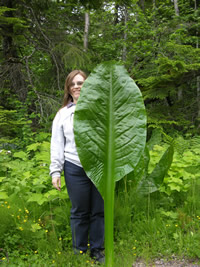DEVIL’S CLUB & SKUNK CABBAGE
 |
 |
Medicinal Properties: anti-inflammatory
Traditional use: draw out infection, dressing wounds, arthritis and other autoimmune disorders, rashes, burns, insect bites.
Customers also recommend use for: Carpel Tunnel, headaches, poison ivy, chigger bites, excema, psorsis.
BALM OF GILEAD – Cottonwood buds
Common Names: Balsalm Poplar, American Balm of Gilead, balm of Gilead buds, Mecca balsam (Back to Eden)
Medicinal Properties: Balsamic -voluntary, counterirritant, expectorant, stimulant, tonic, diuretic, nephritic, demulcent, cathartic, peristaltic and nutritive (Wilderness Medicines), anti-inflammatory, vasodilator, antimicrobial, stimulant to skin proliferation (Medicinal Plants of the Pacific Northwest).
History: Balm of Gilead is mentioned in the Bible. It was so valued by the ancient Egyptians that thebudding trees were guarded bysoldiers.
Traditional use: dry or injured skin including cuts, scrapes, rashes, psorsis, excema, bruises, bedsores, frostbite. Rub ointment under or inside of nose to relieve congestion from colds, catarrh, bronchitis. Sprains, hyperextensions, arthritic joints, pain & swelling, burns, stimulates skin regeneration.
COMFREY – Promotes growth of new cells and has great healing power.

Common Names: Blackwort, bruisewort, gum plant, healing herb, knitback, slippery root, wallwort, nipbone.
Medicinal Properties: Demulcent, astringent, pectoral, vulnerary, mucilaginous, styptic, nutritive.
Traditional use: bruises, swellings, sprains, fractures, boils, ruptures, fresh wounds, ulcers, burns, gangrenous sores, insect bites, pimples, abrasions, reducing inflammation, skin rashes, varicose veins.
Comfrey contains large quantities of Allantoin about which the FDA has said: Based on the wide use and clinical acceptance of Allantoin, as well as published reports in the literature, the FDA has approved the following statements for non-prescription, drug products containing Allantoin at 0.5% to 2.0%.
- For the temporary protection of minor cuts, scrapes, burns and sunburn.
- Helps prevent and temporarily protect chafed, chapped, cracked, orwind-burned skin and lips.
- Relieves dryness and softens cold sores and fever blisters.
- Helps treat and prevent diaper rash. Protects chafed skin/minor skin irritation due to/associated with diaper rash and helps protect from/seal out wetness.

Common Names: Waybread, round-leaved plantain, Englishman’s foot, common plaintain, ribwort, ripple grass, snake weed.
Medicinal Properties: Antibacterial, alternative, diuretic, antisyphilitic, antiseptic, astringent, deobstruent, styptic, vulnerary
Traditional use: Close and heal open wounds, sores, ulcers, insect bites and stings, infections, hemorrhoids, pain relief, body sores, erysipelas, eczema, burns, scalds.

Common Name: Old Man’s Beard, Beard Moss, Woman’s Long Hair, Sodium Usniate, Tree Moss, Tree’s Dandruff, Usnea Lichen, Usnic Acid
Medicinal Properties: Antifungal, Antiparasitic, Antibacterial, Immune regulator and supporter.
Traditional use: tinea infections (ringworm, athletes foot, Candida albicans), Trichomonas and Chalmydia in vaginal infections, gram positive bacteria in local or systemic infections, inflammation. Contains potent broad spectrum antibiotics.
References:
Buchman, Dian Dincin. Herbal Medicine: The Natural Way to Get Well and Stay Well. Gramercy Publishing Co, New York, 1980.
Elias, Jason M.A., L.Ac and Shelagh Ryan Masline. The A to Z Guide to Healing Herbal Remedies. Dell Publishing, New York, 1995.
Howard, Michael. A-Z of Traditional Herbal Remedies. Random House UK Ltd., London, 1997.
Kloss, Jethro. Back to Eden: New Revised Edition. Back to Eden Books Publishing Co, Loma Linda, CA, 1988. (Original copyright in 1939)
Stengler, Mark ND. The Natural Physician: Your Health Guide for Common Ailments. Alive Books, Burnaby, BC Canada, 1997.

